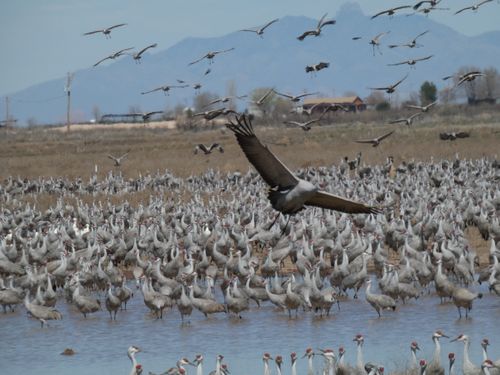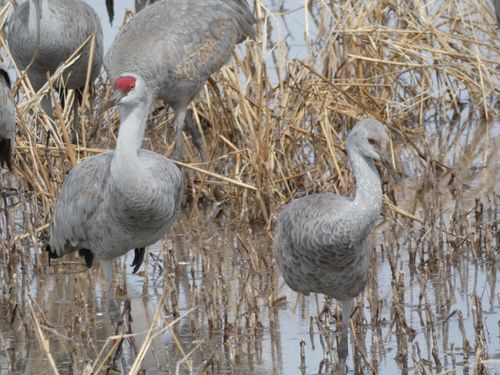Whitewater Draw Mystery
Listen to this:
It's been over a year since I recorded this in March 2019 and I’m only just beginning to understand what it is.
We arrived late, the graded dirt road violently vibrating my Honda Fit. After a few minutes of straining to hear, I turned off the radio and listened to the sound of every piece of my car and body rattle. We pulled into the dirt parking area, shut off the engine and stepped outside into the cool night air. Suddenly free from the confines of the car, our ears began to open up beyond the immediate vicinity, expanding outward in every direction into the darkness...until we heard them.
My girlfriend Nell and I had come to Whitewater Draw on the last night of February to experience the Sandhill Cranes that winter at this 600-acre wetland in the southeast corner of Arizona. A huge striking bird, I had only previously seen handfuls of migrating cranes off rural county roads outside Phoenix. Hearing tens of thousands of them at night though, distant, yet filling the darkness with their prehistoric trumpeting croaks and screams was awe-inspiring.
In the morning, we were posted up by the wetland before sunrise, soaking in the sights and sounds before the cranes took off to forage in nearby agricultural fields for the morning.
Fun fact about Sandhill Cranes: their tracheas are elongated and coiled into their sternum. This tracheal elongation allows the cranes to have deeper, more harmonically rich voices with lower formant frequencies, making them sound even larger than they already are. The coiling around the sternum, a clever way to fit this elongated trachea into a crane body, is also thought to allow the sternum to act as a amplifying resonator. In other words, it helps the cranes croak and scream at ear-shattering volume. Cranes are amazing.
Once most of the cranes had departed for the morning we were left to wander the grounds to see what other birds and critters were around — which brings us to the aforementioned recording that has transfixed me ever since. In a tiny murky pond opposite the cranes were a pair of Northern Shovelers, striking ducks with large spade-shaped bills, and an interesting sound. I pointed my parabolic microphone towards the shovelers, slipped on my headphones and pressed record. Here it is again:
So good. A low clucking sound, sometimes phoneticized as ‘Tsook’ is the most common Northern Shoveler vocalization so that seemed to account for some of what can be heard. The grunty-smoochy sounds, however, were something I was unfamiliar with. I chalked it up to a high-intensity courtship vocalization that is only given at specific times of year (by exceptionally horny birds) and filed it away.
In the coming months, I would return to the recording and try to find any mention of this grunty-smoochy Northern Shoveler vocalization. The excellent Peterson Field Guide to Bird Sounds curated by Nathan Pieplow is my go-to resource for a concise yet near-comprehensive recorded catalogue of bird vocalizations in North America — but this sound was absent. I browsed the extensive offerings at the Macaulay Library and Xeno-Canto but still could not find this vocalization. Even the Birds of the World account had no mention of this vocalization as far as I could tell, though I often find text descriptions of bird vocalizations a bit inscrutable:
McKinney (McKinney 1970) recorded rhythmical wheezy whe or thic or quiet took notes by males during copulation; also recorded one male giving a long sighing noise at copulation. Postcopulatory behavior by males usually includes a loud, nasal paaay, followed by a series of repeated calls.https://birdsoftheworld.org/bow/species/norsho/cur/sounds
Audio recording of birds is still a relatively young pursuit. While it is quickly gaining popularity, it is still not widely adopted by the birding world so the possibility of recording an uncommon or cryptic vocalization for the first time is a real possibility (especially when you add state or county location qualifiers). I excitedly wondered if I had made such a recording breakthrough. It wasn’t until early the next spring when I heard the sound coming from the edge of a mucky pond with not a duck in sight that I began to suspect this was no shoveler sound at all.
Growing up in Phoenix, I rarely had occasion to listen to frogs and until recently have not given them much thought. With a sneaking suspicion I got ahold of Lang Elliott’s beautiful Frogs and Toads of North America and listened to all 99 tracks and 70 minutes. I was floored. The diversity of frog sounds and their charming wonkiness were completely entrancing. Still new to frog sound ID, I could say my grunty-smoochers were probably one of a handful of leopard frog species found in Arizona. A quick perusal of the Arizona Game and Fish Department website revealed Whitewater Draw is home to the Plains Leopard Frog.
It turns out my “Northern Shoveler” recording is almost entirely non-avian. The frogs that I failed to notice were likely giving what is referred to as an advertisement call. Frog advertisement calls are thought to function similarly to bird song in establishing territory, attracting females, repelling rival males. As with most animal vocalizations though, more nuances are likely to be found with closer study. These advertisement calls were apparently ineffectual on me but through sheer bizarreness eventually drew me into the wonderful world of amphibian acoustics. This is why I love paying attention to sounds, whether they’re birds, frogs, music or especially unknown sounds: you might learn something. And it is fun.

